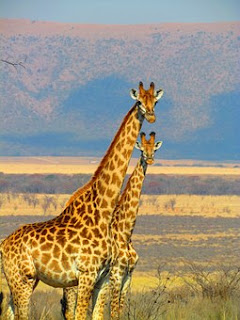KSTT 2019 - ARUSHA NATIONAL PARK
The closest national park to Arusha town – northern
Tanzania’s safari capital – Arusha National Park is a multi-faceted jewel,
often overlooked by safarigoers, despite offering the opportunity to explore a
beguiling diversity of habitats within a few hours.
The entrance gate leads into shadowy montane forest inhabited
by inquisitive blue monkeys and colourful turacos and trogons – the only place
on the northern safari circuit where the acrobatic black-and-white colobus
monkey is easily seen. In the midst of the forest stands the spectacular
Ngurdoto Crater, whose steep, rocky cliffs enclose a wide marshy floor dotted
with herds of buffalo and warthog.
Further north, rolling grassy hills enclose the tranquil
beauty of the Momela Lakes, each one a different hue of green or blue. Their
shallows sometimes tinged pink with thousands of flamingos, the lakes support a
rich selection of resident and migrant waterfowl, and shaggy waterbucks display
their large lyre-shaped horns on the watery fringes. Giraffes glide across the
grassy hills, between grazing zebra herds, while pairs of wide-eyed dik-dik
dart into scrubby bush like overgrown hares on spindly legs.
Although elephants are uncommon in Arusha National Park, and
lions absent altogether, leopards and spotted hyenas may be seen slinking
around in the early morning and late afternoon. It is also at dusk and dawn
that the veil of cloud on the eastern horizon is most likely to clear,
revealing the majestic snow-capped peaks of Kilimanjaro, only 50km (30 miles)
distant.
But it is Kilimanjaro’s unassuming cousin, Mount Meru - the fifth highest in Africa at 4,566 metres (14,990 feet) – that dominates the park’s horizon. Its peaks and eastern footslopes protected within the national park, Meru offers unparalleled views of its famous neighbour, while also forming a rewarding hiking destination in its own right.
But it is Kilimanjaro’s unassuming cousin, Mount Meru - the fifth highest in Africa at 4,566 metres (14,990 feet) – that dominates the park’s horizon. Its peaks and eastern footslopes protected within the national park, Meru offers unparalleled views of its famous neighbour, while also forming a rewarding hiking destination in its own right.
Passing first through wooded savannah where buffalos and
giraffes are frequently encountered, the ascent of Meru leads into forests
aflame with red-hot pokers and dripping with Spanish moss, before reaching high
open heath spiked with giant lobelias. Everlasting flowers cling to the alpine
desert, as delicately-hoofed klipspringers mark the hike’s progress. Astride
the craggy summit, Kilimanjaro stands unveiled, blushing in the sunrise.
About Arusha National Park
Size: 552 sq km 212 sq miles). Location: Northern Tanzania, northeast of Arusha town..
Getting there
An easy 40-minute drive from Arusha. Approximately 60 km (35 miles) from Kilimanjaro International Airport. The lakes, forest and Ngurdoto Crater can all be visited in the course of a half-day outing at the beginning or end of an extended northern safari. NOTE: Mountain Climbing Permits duration time is 12 HOURS.
What to do
Forest walks, numerous picnic sites; three- or four-day Mt Meru climb - good acclimatisation for Kilimanjaro. |
When to go
To climb Mt Meru, June-February although it may rain in November.
Best views of Kilimanjaro December-February.
To climb Mt Meru, June-February although it may rain in November.
Best views of Kilimanjaro December-February.
Accommodation
Two lodges, two rest houses, camp sites, two mountain huts inside the park; more lodges at Usa River outside the park and many hotels and hostels in Arusha town.
Two lodges, two rest houses, camp sites, two mountain huts inside the park; more lodges at Usa River outside the park and many hotels and hostels in Arusha town.
- Animals & Wildlife
Common
animals in Arusha National Parks:
·
Giraffe
·
Buffalo
·
Zebra
·
Black & White Colobus
Occassionaly
seen:
·
Elephants
·
Hippo
Rarely
seen:
* Wildebeest
* Leopard
* Hyena
Very
rarely seen:
·
Cheetah
·
Wild Dog
Wildlife
Photos
Animals &
Wildlife in Arusha National Park
Arusha National Park is the
"odd one out" in Tanzania'sNorthern Safari Circuit. It doesn't offer
the usual range of wildlife that the other parks do. Among The Big 5, only Buffalo
are regularly seen and lion and rhino are absent. It's appeal lies in scenic
beauty and unusual animals. The charismatic Black & White Colubus monkey is
the flagship species.
Wildlife highlights
The forest in Arusha National Park
is home to species not often encountered in other parks in northern Tanzania,
including blue Monkeys and black and white colobus. If you are lucky, you might
also spot a shy Red Duiker. More common is the even smaller Kirk’s Dik – Dik.
Giraffes are very common in the area around the Momella lakes.
Best time for wildlife viewing
The Dry season from June to October
is the best time for game viewing in the park. Wildlife is easier to spot
because vegetation is thinner and animals gather around predictable water
resources.



Amazing Blog! This is really an interesting and joyful blog. I really liked the way of describing best time to climb Kilimanjaro. A common person can easily understand when they plan to trip to climb Kilimanjaro.I had gone to Kilimanjaro for a tour of two days with my friends by the help of Tanzania Joy Tours, which is best Travel Agency in Tanzania. Thank you very much for giving such kind of information with us.
ReplyDeleteIt is one of the more peaceful destinations in North Africa. Absolutely, I love Kilimanjaro. You feel secure and people are really friendly and helpful there. The most interesting place in Kilimanjaro is Arusha National Park.
ReplyDeleteBest Time To Climb Kilimanjaro